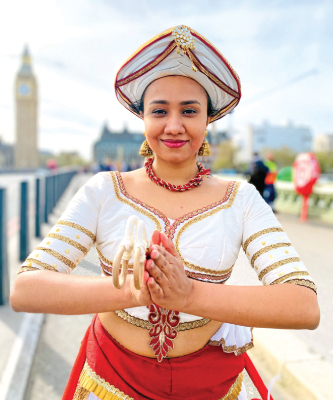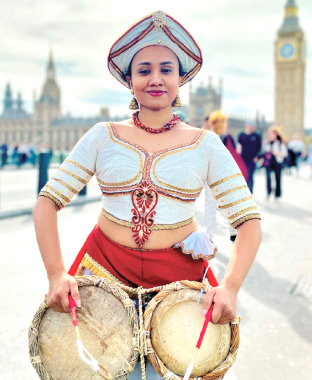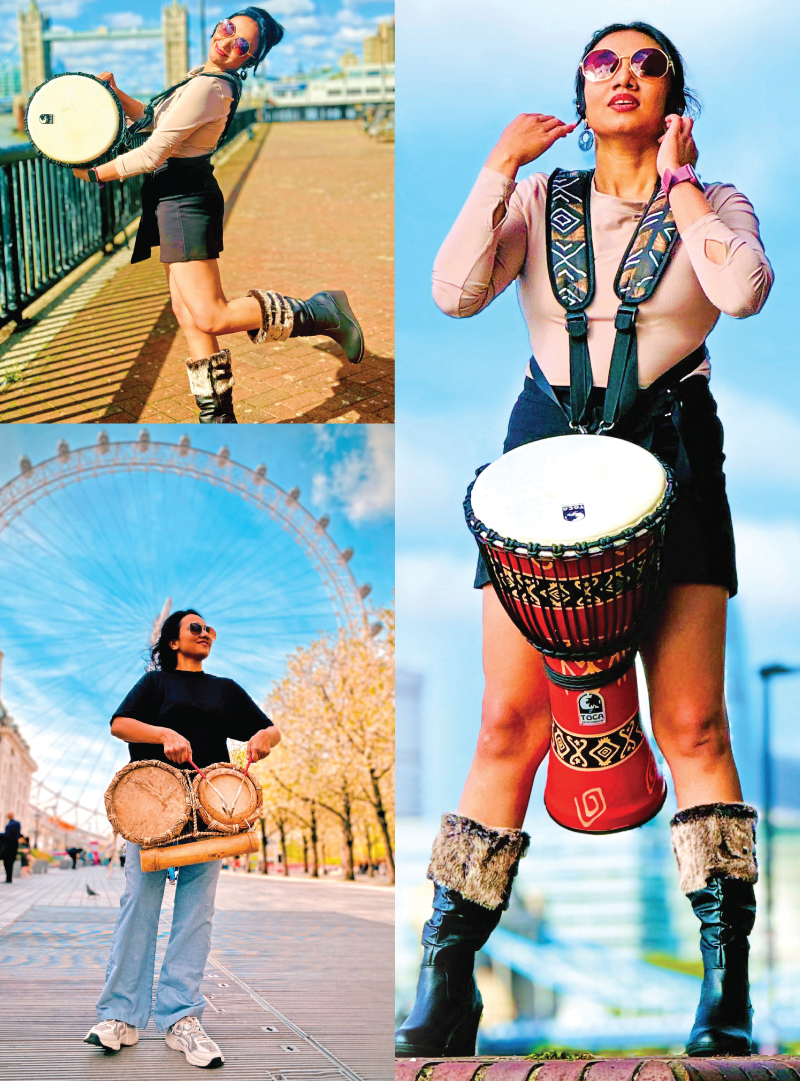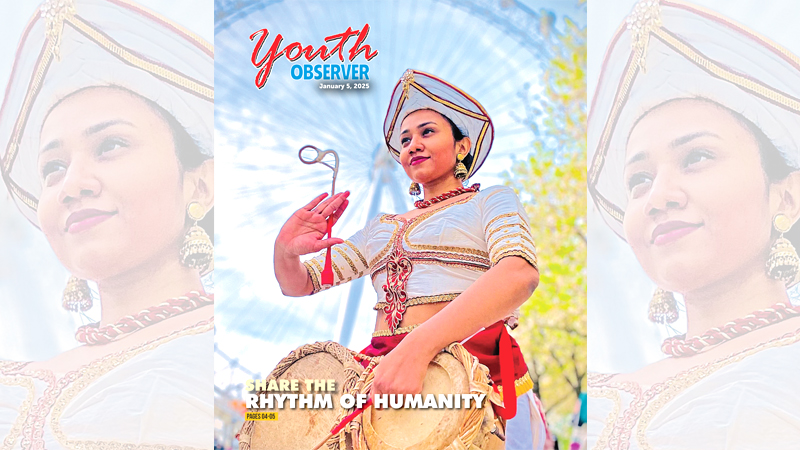 In a world where tradition often dictates roles and stifles dreams, Sithara Maduwanthi rises as a beacon of hope and rhythm. This remarkable young woman, with no illustrious lineage to herald her arrival, embodies what it means to carve one’s own path. As Sri Lanka’s first female percussionist and the visionary founder of Thuryaa, an all-female drum ensemble born from the hearts of university students, she challenges the age-old notion that drums are a man’s domain. For a decade, Thuryaa has defied societal norms and shone bright, transforming the once-taboo practice of women drumming into a powerful statement of passion and determination. With a warm “Hello” to 2025, Youth Observer is thrilled to connect with this talented young woman, now pursuing her higher studies in the UK while passionately continuing her work with Thuryaa. This write-up celebrates her incredible journey of breaking taboos and daring to think big, inspiring others along the way.
In a world where tradition often dictates roles and stifles dreams, Sithara Maduwanthi rises as a beacon of hope and rhythm. This remarkable young woman, with no illustrious lineage to herald her arrival, embodies what it means to carve one’s own path. As Sri Lanka’s first female percussionist and the visionary founder of Thuryaa, an all-female drum ensemble born from the hearts of university students, she challenges the age-old notion that drums are a man’s domain. For a decade, Thuryaa has defied societal norms and shone bright, transforming the once-taboo practice of women drumming into a powerful statement of passion and determination. With a warm “Hello” to 2025, Youth Observer is thrilled to connect with this talented young woman, now pursuing her higher studies in the UK while passionately continuing her work with Thuryaa. This write-up celebrates her incredible journey of breaking taboos and daring to think big, inspiring others along the way.
In a culture where playing traditional drums has long been reserved for men and where women have remained largely invisible in the sacred space of Kandyan dance, Thuryaa stands as a magnificent rebellion against the status quo. Just as Vajira Chithrasena boldly broke barriers for women in dance, Maduwanthi and her ensemble have skillfully tapped into their own creative rhythm, creating a rich tapestry of sound that resonates with courage and vitality. As they celebrate a decade of fearless artistry, it’s an opportune moment to reflect on their extraordinary journey, a tale woven with resilience, talent and an unwavering commitment to challenge conventions in pursuit of their dreams.
As Sithara Maduwanthi embarked on her journey at the University of Visual and Performing Arts, she was struck by the absence of women in the Department of Percussion Music. Undeterred, she pursued her passion, ultimately becoming the institution’s first female percussion music graduate. “I knew I loved this subject, and that was enough for me to break the mold,” she recalls.
 During her studies, at the university a chance invitation from her friend Dilan to an international conference sparked a new idea. “We didn’t think big at the time; we just wanted to make music,” Sithara reflects, as she and a group of enthusiastic women came together, united by their love for drumming.
During her studies, at the university a chance invitation from her friend Dilan to an international conference sparked a new idea. “We didn’t think big at the time; we just wanted to make music,” Sithara reflects, as she and a group of enthusiastic women came together, united by their love for drumming.
With the support from lecturers and borrowed instruments, they faced scepticism from the Head of the Department but confidently declared, “Why not? Let’s build this female ensemble!” This determination led to the birth of Thuryaa in 2015, a vibrant collective of twelve committed performers. Their inaugural show featured innovative body percussion, demanding dedication and resilience. “It was challenging,” Sithara admits, highlighting the struggle that solidified their commitment. With this foundation, they not only transformed their lives but also began to challenge the rhythms of tradition itself.
Challenging physicality
The journey of female percussionists of the likes of Sithara and her ensemble Thuryaa is not merely one of artistic expression, it fundamentally exposes the physical and psychological hardship women face in a field traditionally dominated by men. The nature of percussion requires a certain physicality, strength, endurance and sometimes an aggressive presence that society often associated with male identities. For women, adapting their bodies to these demands can be a complex negotiation of self-image and societal expectations. As they confront the stereotype that drums and physical force belong to men, female percussionists must wrestle with the cultural narrative that often undermines their abilities.
Sithara’s experiences echo this struggle, her ascent in a male-centric environment of percussion not only necessitated honing her skills but also challenging the perceptions of women’s physical capabilities. As she and her team take to the stage, they do not just perform music; they embody a defiance against a backdrop of traditional beliefs that dictate how women should present their bodies, soft and graceful, rather than strong and commanding. Their success in developing a cohesive all-female ensemble indicates a significant step toward normalising women in roles that require both physical and creative fortitude.
Sithara’s artistic practice encapsulates a bold thematic and contemporary approach that redefines traditional Sri Lankan drumming within a modern context. By blending drumming with everyday objects, such as bottles and kitchen items, she transforms rhythmic patterns into narratives, infusing performances with a fresh, feminine perspective. This innovative framework not only incorporates clapping, tapping and dance but also heightens the emotional resonance of storytelling, creating an interactive experience that captivates audiences. In her signature Thammattam act, Sithara expertly merges traditional Sri Lankan Thaal (beat) systems with Western beat elements, employing dynamic techniques such as cross-hand beats to foster seamless collaboration among multiple players. This hybridity retains the essence of traditional drumming while making it accessible to global audiences, transcending language barriers and evolving into a rich audio-visual experience.
 Explaining her art practice, Sithara said, “traditional drumming in Sri Lanka has long been rooted in a male-dominated culture. My challenge was to bring these drumming arts to the stage in a dynamic, performative way, adding a feminine touch and infusing emotion into the raw, rhythmic beats. I explored multiple approaches to transform traditional Sri Lankan drumming into a vibrant art form, focusing on infusing emotion into the otherwise raw and structured rhythms.”
Explaining her art practice, Sithara said, “traditional drumming in Sri Lanka has long been rooted in a male-dominated culture. My challenge was to bring these drumming arts to the stage in a dynamic, performative way, adding a feminine touch and infusing emotion into the raw, rhythmic beats. I explored multiple approaches to transform traditional Sri Lankan drumming into a vibrant art form, focusing on infusing emotion into the otherwise raw and structured rhythms.”
Remarkable journey
Performing at prestigious international stages, including the New Taipei Drum Art Festival showcases the act’s evolution and universal appeal. In 2024, her ensemble Thuryaa electrified a prominent national event by crafting intricate drumming beats that complemented popular tele-drama songs, enhancing energy and dynamics through meticulous composition.
Sithara’s commitment to a distinct feminine identity in her work shapes each beat pattern to be both soft and powerful, while technical precision remains paramount as she presents to professional audiences.
Her philosophy, “Share the rhythm of humanity,” embodies her belief in the transcendental power of art, inviting discussions that challenge gender norms and stereotypes within drumming. Driven by a vision of inclusivity, she empowers not only women but also men through her innovative drumming pieces, fostering a shared rhythm that resonates beyond cultural and societal boundaries. Overall, Sithara’s practice is a testament to the potential of art to break barriers and inspire change, positioning her as a pioneer and a critical voice in the evolution of the percussion arts.
Transformative movement
Sithara stands in the forefront of a transformative movement in Sri Lanka’s musical landscape, yet her journey evokes a critical examination of societal constraints and the limitations faced by female artistes in a predominately patriarchal society. Her ambition to establish Thuryaa, the first all-female drumming ensemble is undeniably groundbreaking. However, the merits of her work must be scrutinised in the context of systemic obstacles and the broader implications for cultural change.
While Sithara draws inspiration from established examples such as Drum Cat, one must question whether mere replication of successful models from abroad can effect meaningful change within Sri Lanka. The vision to mimic the structure of a male-dominated ensemble such as Naadro raises concerns about the authenticity of her intent. Is Thuryaa an empowering initiative in its own right, or does it risk becoming a superficial answer to a much deeper issue of gender inequality in the arts?
Sithara’s assertion that “there is no gender divide for the arts” is a noble sentiment, but it oversimplifies the entrenched realities faced by female percussionists in Sri Lanka. The disconnect between this idealistic view and the lived experiences of women in traditional performance settings reveals a stark contradiction.
While she dismisses the notion of gender roles in art, the very cultural context from which she emerges continues to perpetuate a hierarchy that privileges male musicians. Her experiences, where picking up a drum invited scrutiny, are not isolated incidents but rather reflect a pervasive scepticism about women’s capabilities in traditionally male domains.
Moreover, the ensemble’s focus on creating joy and connection through performance raises critical questions about the broader impact of their initiative.
While the intent to “share the rhythm of humanity” may resonate on a personal level, it risks placing the burden of change solely on the shoulders of the artistes. In doing so, it potentially neglects the need for systemic reform within the cultural fabric of Sri Lanka. The call for joy in art should not detract from the pressing need to address the inequities that inhibit women’s participation in percussion.
To genuinely alter the narrative around women in drumming, a more robust engagement with cultural institutions, educational reforms and community dialogues is essential.
Sithara’s pioneering efforts certainly lay the groundwork for future generations, yet, for her work to foster lasting change, it must evolve beyond mere performance. It ought to challenge societal norms, confront stereotypes head-on and inspire a rethink of women’s roles in all areas of the arts.
Ultimately, while Sithara Maduwanthi’s achievements are commendable and significant, they serve as a microcosm for a larger conversation about gender, tradition and artistic expression in Sri Lanka.
It is crucial to evaluate not just what she has accomplished but also how her efforts can evolve into a transformative movement that truly empowers women and reshapes societal perceptions about their capabilities in music and beyond.








